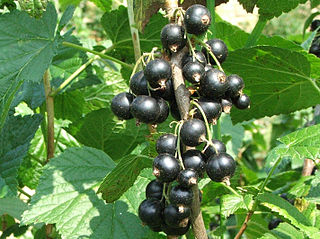In biology, the BBCH-scale for currants describes the phenological development of currants, such as blackcurrants and redcurrants, using the BBCH-scale.

Phenology is the study of periodic plant and animal life cycle events and how these are influenced by seasonal and interannual variations in climate, as well as habitat factors. The word, coined by the Belgian botanist Charles Morren around 1849, is derived from the Greek φαίνω (phainō), "to show, to bring to light, make to appear" + λόγος (logos), amongst others "study, discourse, reasoning" and indicates that phenology has been principally concerned with the dates of first occurrence of biological events in their annual cycle. Examples include the date of emergence of leaves and flowers, the first flight of butterflies and the first appearance of migratory birds, the date of leaf colouring and fall in deciduous trees, the dates of egg-laying of birds and amphibia, or the timing of the developmental cycles of temperate-zone honey bee colonies. In the scientific literature on ecology, the term is used more generally to indicate the time frame for any seasonal biological phenomena, including the dates of last appearance.

The blackcurrant or black currant is a woody shrub in the family Grossulariaceae grown for its berries. It is native to temperate parts of central and northern Europe and northern Asia where it prefers damp fertile soils and is widely cultivated both commercially and domestically. It is winterhardy, but cold weather at flowering time during the spring reduces the size of the crop. Bunches of small, glossy black fruit develop along the stems in the summer and can be harvested by hand or by machine. The raw fruit is particularly rich in vitamin C and polyphenol phytochemicals. Blackcurrants can be eaten raw but are usually cooked in a variety of sweet or savoury dishes. They are used to make jams, jellies and syrups and are grown commercially for the juice market. The fruit is also used in the preparation of alcoholic beverages and both fruit and foliage have uses in traditional medicine and the preparation of dyes.

The redcurrant, or red currant is a member of the genus Ribes in the gooseberry family. It is native across Europe. The species is widely cultivated and has escaped into the wild in many regions.
The phenological growth stages and BBCH-identification keys of currants are:
| Growth stage | Code | Description |
|---|---|---|
| 0: Sprouting/Bud development | 00 | Dormancy: leaf buds and the thicker inflorescence buds closed and covered by dark brown scales |
| 01 [1] | Beginning of bud swelling: bud scales elongated | |
| 03 | End of bud swelling: edges of bud scales light coloured | |
| 07 | Beginning of bud burst: first green or red leaf tips just visible | |
| 09 | Leaf tips extended beyond scales | |
| 1: Leaf development | 10 | Leaf tips above the bud scales: first leaves separating |
| 11 | First leaves unfolded (others still unfolding) | |
| 15 | More leaves unfolded, not yet full size | |
| 19 | First leaves fully expanded | |
| 3: Shoot development1 | 31 | Beginning of shoot growth: axes of developing shoots visible |
| 32 | Shoots about 20% of final length | |
| 33 | Shoots about 30% of final length | |
| 3 . | Stages continuous till . . . | |
| 39 | Shoots about 90% of final length | |
| 5: Inflorescence emergence | 51 | Inflorescence buds and leaf buds swelling: buds closed, light brown scales visible |
| 53 | Bud burst: scales separated light green but sections visible | |
| 54 | Green or red leaf tips above bud scales | |
| 55 | First flower buds (compact raceme) visible beside unfolded leaves | |
| 56 | Beginning of raceme elongation | |
| 57 | First flower bud separated on elongating raceme | |
| 59 | Grape stage: all flower buds separated | |
| 6: Flowering | 60 | First flowers open |
| 61 | Beginning of flowering: about 10% of flowers open | |
| 65 | Full flowering: at least 50% of flowers open, first petals falling | |
| 67 | Flowers fading: majority of petals fallen | |
| 69 | End of flowering: all petals fallen | |
| 7: Development of fruit | 71 | Beginning of fruit growth: first fruits visible at raceme base |
| 72 | 20% of fruits formed | |
| 73 | 30% of fruits formed | |
| 74 | 40% of fruits formed | |
| 75 | 50% of fruits formed | |
| 76 | 60% of fruits formed | |
| 77 | 70% of fruits formed | |
| 78 | 80% of fruits formed | |
| 79 | 90% of fruits formed | |
| 8: Maturity of fruit and seed | 81 | Beginning of ripening: change to cultivar-specific fruit color |
| 85 | Advanced ripening: first berries at base of racemes have cultivar-specific color | |
| 87 | Fruit ripe for picking: most berries ripe | |
| 89 | Berries at base of racemes tending to drop (beginning of fruit abscission) | |
| 9: Senescence, beginning of dormancy | 91 | Shoot growth completed; terminal bud developed; foliage still fully green |
| 92 | Leaves begin to discolour | |
| 93 | Beginning of leaf fall | |
| 95 | 50% of leaves discoloured or fallen | |
| 97 | All leaves fallen | |
| 99 | Harvested product | |